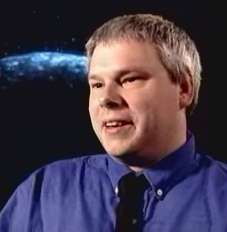Ian P. Griffin
Ian P. Griffin (born 1966) is a British astronomer, discoverer of minor planets and a public spokesman upon scientific matters. He is currently the Director of Otago Museum, Dunedin, New Zealand. Griffin was the CEO of Science Oxford, in Oxford, United Kingdom, and the former head of public outreach at NASA's Space Telescope Science Institute.

Biographical information
Griffin began his professional life at University College London where he decided to pursue a career combining both astronomical research and public outreach. He was director of the Armagh Planetarium from 1990 to 1995. He then worked at Astronaut Memorial Planetarium and Observatory at Brevard Community College in Cocoa, Florida and Auckland Observatory in New Zealand before accepting the position as head of public outreach at the Space Telescope Science Institute in Baltimore, US.[1]
From 2004 to 2007 Griffin was director of the Museum of Science and Industry in Manchester.[2]
Griffin studied and trained to be an astronomer. He obtained his PhD in astronomy from University College London, in 1991.[3]
Griffin has a strong Twitter presence and regularly updates followers with photos of the Aurora Australis and of other astronomical phenomena.
Significant achievements
| 10924 Mariagriffin | 29 January 1998 | MPC |
| 11678 Brevard | 25 February 1998 | MPC |
| 13376 Dunphy | 15 November 1998 | MPC |
| 14179 Skinner | 15 November 1998 | MPC |
| 17020 Hopemeraengus | 24 February 1999 | MPC |
| 23988 Maungakiekie | 2 September 1999 | MPC |
| 23990 Springsteen | 4 September 1999 | MPC |
| 25273 Barrycarole | 15 November 1998 | MPC |
| 27120 Isabelhawkins | 28 November 1998 | MPC |
| 31239 Michaeljames | 21 February 1998 | MPC |
| 31268 Welty | 16 March 1998 | MPC |
| 33179 Arsènewenger | 29 March 1998 | MPC |
| (44527) 1998 YC6 | 22 dicembre 1998 | MPC |
| (49291) 1998 VJ | 8 November 1998 | MPC |
| (53109) 1999 AD5 | 12 January 1999 | MPC |
| (66856) 1999 VW22(*) | 13 November 1999 | MPC |
| 85773 Gutbezahl | 25 October 1998 | MPC |
| 101461 Dunedin | 25 November 1998 | MPC |
| (101462) 1998 WW7 | 25 November 1998 | MPC |
| 101491 Grahamcrombie | 1 December 1998 | MPC |
| (108736) 2001 OG32(*) | 24 July 2001 | MPC |
| (134483) 1998 WK2 | 19 November 1998 | MPC |
| (135045) 2001 OF32(*) | 24 July 2001 | MPC |
| (155487) 1998 WP8 | 27 November 1998 | MPC |
| (192609) 1999 GY3 | 12 April 1999 | MPC |
| (*) in collaboration with N. Brady | ||
|---|---|---|
In his time at Space Telescope, Griffin contributed to the observation and study of a scientifically significant binary asteroid system, known as 1998 WW31.[5] This was only the second such binary system discovered in the Kuiper belt (the other being the Pluto and Charon system) and provided valuable data helping astronomers understand the mass and behaviour of objects in the Kuiper belt.[6]
Via search programmes using small telescopes, Griffin also discovered 26 numbered minor planets between 1998 and 2001.[4] Three of his discoveries were made in collaboration with Australian astronomer Nigel Brady. His discovery include:
- 10924 Mariagriffin, named after his wife Maria (b. 1962)[7]
- 23990 Springsteen, named after American musician Bruce Springsteen[8]
- 33179 Arsènewenger, named after Arsène Wenger, the former manager of Griffin's favourite football team, Arsenal[9]
However the Mars-crossing asteroid 4995 Griffin is unrelated to him, as it was named after Griffin Swanson the son of its discoverer Steven Roger Swanson.[10]
In 2015, Griffin was awarded the New Zealand Prime Minister's Science Communication Prize, worth NZD 100,000, for his work at Otago Museum.[11]
References
- Trifourki, Sotira (Manchester Astronomical Society) (2005). "Observing Solar System Objects with the Hubble Space Telescope". Retrieved 18 January 2006.
- Ottewell, David (14 January 2004). "Science museum lands space ace". Manchester News.
- Griffin, Ian (2013). "Ian Griffin's Blog". Archived from the original on 2014-10-14.
- "Minor Planet Discoverers (by number)". Minor Planet Center. 23 May 2016. Retrieved 19 June 2016.
- Christian Veillet, Joel Wm. Parker; et al. (2002). "The binary Kuiper-belt object 1998 WW31" (PDF). Nature. 416 (18 April 2002): 711–713. Bibcode:2002Natur.416..711V. doi:10.1038/416711a. PMID 11961547.
- "Hubble Hunts Down Binary Objects at the Fringe of Our Solar System" (Press release). NASA STSci. April 17, 2002.
- Schmadel, Lutz D. (2007). "(10924) Mariagriffin". Dictionary of Minor Planet Names – (10924) Mariagriffin. Springer Berlin Heidelberg. p. 749. doi:10.1007/978-3-540-29925-7_8168. ISBN 978-3-540-00238-3.
- Schmadel, Lutz D. (2007). "(23990) Springsteen". Dictionary of Minor Planet Names – (23990) Springsteen. Springer Berlin Heidelberg. p. 873. doi:10.1007/978-3-540-29925-7_9760. ISBN 978-3-540-00238-3.
- "33179 Arsenewenger (1998 FY15)". Minor Planet Center. Retrieved 19 July 2016.
- "4995 Griffin (1984 QR)". Minor Planet Center. Retrieved 19 July 2016.
- "2015 Prime Minister's Science Media Communicators Prize | The Prime Minister's Science Prizes". www.pmscienceprizes.org.nz. Retrieved 2018-02-08.